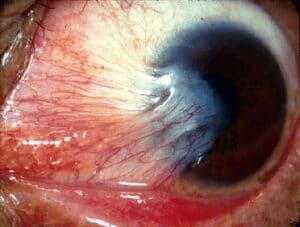Why Sun Glasses Matter

Good news: Sun glasses are not just for looking cool these days. Believe it or not, the sun’s UV rays created the damage on the eye seen in this blog post. It turns out that the sun can damage your eyes on the front (as seen here with a severe pterygium), the middle, and most importantly, in the back of the eyes. Read on to learn why sun glasses matter.
Eye issues related to UV damage typically starts out as a relatively benign pinguecula. Pinguecula is a mild yellowing and thickening of the clear skin over the white of your eye (the conjunctiva) and can progress to significant bumps in the tissue that form at 3 & 9:00 on either side of the corneas. These bumps are evidence of permanent damage and can get inflamed and irritated, creating a condition called “pingueculitis” that needs to be treated with prescription eye drops by your local eye doctor.
Given more sun exposure and maybe some dry/dusty conditions to exacerbate things, the situation will worsen over the years. Over time the condition progresses in patients who don’t wear sun glasses, and can even progress an early form of the Pterygium seen in the photo for this blog post. An early Pterygium may cause irritation or some shifts in the astigmatism portion of a patient’s prescription. The astigmatism change has to do with the growth on the cornea (ie. the pterygium) causing traction that warps the lens.
Speaking of the unsightly UV damage on the eye in the photo, that is a problem that we rarely see in patients who grew up in the Seattle, especially if they are sun glasses wearers. Significant sun damage is more likely to be in your eyes if you grew up somewhere hot and sunny like Texas or Southern California. Even NorthWest natives can accumulate enough sun damage if their work or passions lead them out doors often. In hot, dry parts of the world, eye doctors see and treat a lot of pterygium.
Treatment for pterygium typically will be necessary when the UV-related eye disease progresses to a point that it is blocking the patient’s vision to some degree. Treatment involves surgery to cut away the excess tissue, and typically has good results after the eye heals. A new glasses (and contact lens) Rx will be needed after eye surgery. Unfortunately, there is a known problem with these things growing back within a few years. So it is best not to get the sun damage in the first place.
Earlier I mentioned that UV damage can effect the eye at three levels: the Front (covered above), the middle (cataracts) and the retina in the back of the eye. If you are going to have an eye problem, cataracts are the one you ‘want’ to have, because it is something we can fix. But nobody wants to deal with cataract surgery in their 50s when it would have otherwise happened in their 70s.
Ultraviolet damage can make cataracts happen earlier for you. So wear your sunglasses. Finally, and most importantly, UV damage can wreak havoc on the macula in the back of the eye. If I were a betting man, I would be willing to bet that you know or knew someone who lost sight to Age-related Macular Degeneration, or AMD as it is commonly called.
AMD is a complex disease that is beyond the scope of this post, but will be covered in the future. Suffice to say at this point that it is the leading cause of blindness in people over age 65 in our country. So you definitely don’t want it. Even if you are reading this at age 15, chances are you don’t want to go blind in 50 years. The three main causes of AMD are:
1. genetics: you obviously can’t do anything about this, but it’s good enough reason to talk to your elders about family eye health. Find out how grandma went blind before your parents die.
2. Smoking: If you smoke, consider stopping if you don’t plan to go blind.
3. Sun Exposure: I strongly suggest you wear some quality sun glasses that block both UVA and UVB on a regular basis.
Sincerely, Dr. Mark Cannon, optometrist @ Cannon EyeCare (at Market Optical) in Seattle, Washington

Good news: Sun glasses are not just for looking cool these days. Believe it or not, the sun’s UV rays created the damage on the eye seen in this blog post. It turns out that the sun can damage your eyes on the front (as seen here with a severe pterygium), the middle, and most importantly, in the back of the eyes. Read on to learn why sun glasses matter.
Eye issues related to UV damage typically starts out as a relatively benign pinguecula. Pinguecula is a mild yellowing and thickening of the clear skin over the white of your eye (the conjunctiva) and can progress to significant bumps in the tissue that form at 3 & 9:00 on either side of the corneas. These bumps are evidence of permanent damage and can get inflamed and irritated, creating a condition called “pingueculitis” that needs to be treated with prescription eye drops by your local eye doctor.
Given more sun exposure and maybe some dry/dusty conditions to exacerbate things, the situation will worsen over the years. Over time the condition progresses in patients who don’t wear sun glasses, and can even progress an early form of the Pterygium seen in the photo for this blog post. An early Pterygium may cause irritation or some shifts in the astigmatism portion of a patient’s prescription. The astigmatism change has to do with the growth on the cornea (ie. the pterygium) causing traction that warps the lens.
Speaking of the unsightly UV damage on the eye in the photo, that is a problem that we rarely see in patients who grew up in the Seattle, especially if they are sun glasses wearers. Significant sun damage is more likely to be in your eyes if you grew up somewhere hot and sunny like Texas or Southern California. Even NorthWest natives can accumulate enough sun damage if their work or passions lead them out doors often. In hot, dry parts of the world, eye doctors see and treat a lot of pterygium.
Treatment for pterygium typically will be necessary when the UV-related eye disease progresses to a point that it is blocking the patient’s vision to some degree. Treatment involves surgery to cut away the excess tissue, and typically has good results after the eye heals. A new glasses (and contact lens) Rx will be needed after eye surgery. Unfortunately, there is a known problem with these things growing back within a few years. So it is best not to get the sun damage in the first place.
Earlier I mentioned that UV damage can effect the eye at three levels: the Front (covered above), the middle (cataracts) and the retina in the back of the eye. If you are going to have an eye problem, cataracts are the one you ‘want’ to have, because it is something we can fix. But nobody wants to deal with cataract surgery in their 50s when it would have otherwise happened in their 70s.
Ultraviolet damage can make cataracts happen earlier for you. So wear your sunglasses. Finally, and most importantly, UV damage can wreak havoc on the macula in the back of the eye. If I were a betting man, I would be willing to bet that you know or knew someone who lost sight to Age-related Macular Degeneration, or AMD as it is commonly called.
AMD is a complex disease that is beyond the scope of this post, but will be covered in the future. Suffice to say at this point that it is the leading cause of blindness in people over age 65 in our country. So you definitely don’t want it. Even if you are reading this at age 15, chances are you don’t want to go blind in 50 years. The three main causes of AMD are:
1. genetics: you obviously can’t do anything about this, but it’s good enough reason to talk to your elders about family eye health. Find out how grandma went blind before your parents die.
2. Smoking: If you smoke, consider stopping if you don’t plan to go blind.
3. Sun Exposure: I strongly suggest you wear some quality sun glasses that block both UVA and UVB on a regular basis.
Sincerely, Dr. Mark Cannon, optometrist @ Cannon EyeCare (at Market Optical) in Seattle, Washington
Pike Place Office
1906 Pike Pl Unit 8-b,
Seattle, WA 98101
University Village Office
2602 NE University Village St,
Seattle, WA 98105
Pike Place Office Hours
Monday
Closed
Tuesday
10:00 am - 5:00 pm
Wednesday
Closed
Thursday
10:00 am - 5:00 pm
Friday
10:00 am - 5:00 pm
Saturday
10:00 am - 5:00 pm
Sunday
Closed
University Village Office Hours
Monday
10:00 am - 6:00 pm
Tuesday
10:00 am - 6:00 pm
Wednesday
10:00 am - 6:00 pm
Thursday
10:00 am - 6:00 pm
Friday
10:00 am - 6:00 pm
Saturday
10:00 am - 6:00 pm
Sunday
Closed
